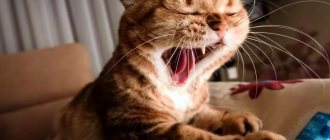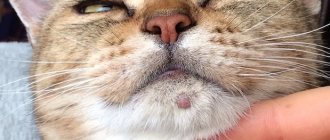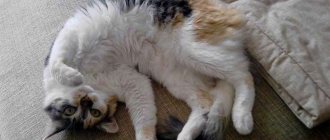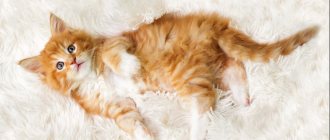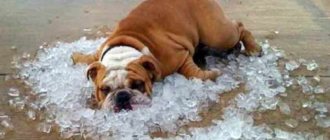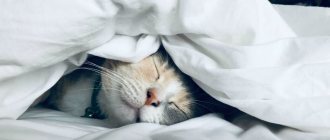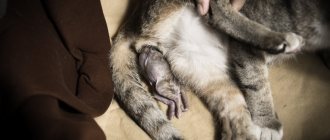For many people, pets are equal members of the family. When we take a bird, cat, dog or any other pet into our home, we are obliged to take care of it, feed it properly, water it, and monitor its health. As a rule, animal owners periodically have various kinds of questions, such as, for example: “Do cats and dogs sweat”, “How to properly create a diet for a sphinx”, “Do a guinea pig need additional vitamins” and others. And this is natural, since we must have information about our pets in order to properly care for them.
Cat is man's friend
A cat in the house is a wonderful sedative for the whole family. Scientists have already proven that these fluffy (and not so fluffy) creatures have the ability to heal their owners - improve heart rate, lower blood pressure, relieve stress and much more.
We, in turn, must also pay enough attention to our friends and help them in difficult times. Providing your pet with adequate nutrition, ensuring compliance with its drinking regime and hygiene is our direct responsibility.
In addition, we still need to know the peculiarities of the functioning of his body in order to prevent health problems. For example, it would help us to know whether cats sweat in order to understand how they thermoregulate. Knowing these features of the body is necessary in order to prevent our pet from overheating in particularly hot weather.
Methods for treating lack of sweating
If the diagnosis is confirmed, the patient requires competent treatment. First of all, it is aimed at eliminating provoking factors. But sometimes the patient needs additional therapy.
Symptomatic therapy
Pathological conditions of the disease require symptomatic treatment:
| Complication | Characteristic signs | First aid |
| Heat cramps | A specific feature of heat cramps is their pain and duration (more significant than night cramps). | A person can cope with this manifestation of anhidrosis on his own. Relax and drink a cool, electrolyte-rich drink. This could be a special composition for athletes or even just juice with ice. If the spasms do not go away within an hour or even get worse, you need to call an ambulance. |
| Heat exhaustion | Tachycardia, headache, nausea, and general weakness occur. | Take the patient to a cool room and place him on the bed, raising his legs. Unbutton the top buttons of your shirt, bra clasp, and belt. Give cool water or an electrolyte-rich drink. Wet the skin with water using a napkin or any other cloth. If there is no relief, call a doctor. |
| Heat stroke due to overheating | Body temperature reaches significant levels (more than 40 degrees). The person experiences hallucinations and possibly a coma. | The patient needs emergency medical care. If it is not provided, even death is possible. Before the ambulance arrives, you need to move the patient to a cool place and wipe the skin with cold water or apply a compress. Air ventilation is required. If there is no air conditioning, fan the patient. |
In case of intense overheating, when there is a risk of serious complications and danger to life, surgical intervention is possible.
Vitamin preparations
Even with a mild form of the disease, a course of vitamin supplements is necessary. If a person sweats little, he/she will benefit from complexes containing vitamins E and A. In difficult cases, intramuscular injections of vitamin B12 are prescribed.
Local treatment
The patient is prescribed wiping areas prone to natural moisture (groin and axillary areas, palms and feet, neck) with moisturizing lotions. It is recommended to lubricate dry, cracked areas with an oil solution of “Retinol acetate” together with its ingestion.
For severely dry skin, rich creams and oil compresses with vitamin A are recommended.
If a significant part of the skin is affected, the patient is prescribed moisturizing indifferent ointments:
Small doses of Pilocarpine and Rezokhin taken orally or during electrophoresis are useful.
Do cats sweat?
Sweating is one of the mechanisms of thermoregulation. Cats sweat, but in a different way than humans. They have a limited number of sweat glands; they are located mainly on the pads of the paws, as well as around the anus and nipples. Does your cat's armpits sweat? No, there are no sweat glands in this area of the body.
Dogs, for example, just like cats, sweat their paws, but their main mechanism of thermoregulation is the evaporation of saliva through their protruding tongue. Cats, like dogs, can also sometimes stick out their tongues when they feel hot. However, if this is the norm for a dog, then in cats this phenomenon can signal other problems not related to heat (even heart failure). If the reason for a cat's tongue sticking out is high air temperature, then you need to know that the cat sticks out its tongue when it is already on the verge of heatstroke.
How to tell if a cat is hot or cold
Mammary cancer in a cat: breast tumor
Some symptoms can easily determine whether a cat is cold or, on the contrary, very hot.
When a pet is cold, it:
- curls up into a ball;
- hides nose;
- sits ruffled;
- demands to eat more often;
- trying to move more.
When a cat is hot, it:
- lies stretched out;
- looking for shade;
- licks himself a lot;
- drinks water often.
The owner of the cat should help her in every possible way: do not forget to pour water into the bowl during the hot season and not force her to move a lot.
Do Sphynx cats sweat?
This cat breed is an exception to the rule.
The lack of hair in sphinxes gives rise to their own characteristics of the body. These cats sweat all over their bodies, this is especially noticeable in completely naked individuals. Some Sphynx owners notice that their pets may leave a mark on the surface on which they like to spend time. These cats require special care; they need periodic baths or wiping their bodies with wet wipes.
How much a Sphynx sweats depends on the individual characteristics of the body and state of health. Some representatives of this breed sweat a little. But it also happens that the sphinx’s profuse sweating is a real problem for the owners, since brown sweat stains on furniture and other surfaces create a certain discomfort.
Thus, to the question “Do Sphynx cats produce sweat?” the answer will be yes. If there is too much sweat, you need to contact a veterinarian, your pet may have health problems.
How cats sweat: location of glands, features of thermoregulation and methods of cooling
Sweating is one of the most useful functions of mammals, which helps reduce elevated body temperature. If nature had not provided this mechanism of thermoregulation, living beings would die from overheating.
In the heat, cats behave calmer; they try to sleep more in the shade
But everyone sweats differently. For example, in cats, sweating is almost invisible. But this does not mean that they lack sweat glands. There are simply very few of them and they are not located throughout the body, like in humans, but in certain places: on the muzzle (on the cheeks and near the lips), at the nipples and on the tips of the paws. These glands work extremely economically: sweat is released only when there is significant overheating or stress. The discharge on the abdomen and muzzle is not visible due to the fur. But bare palms of cats sweat more. Perhaps during extreme heat or during a visit to the veterinarian, you have noticed that your furry pet leaves wet marks.
The cat's "palms" sweat the most.
How do cats cope with thermoregulation with such poor sweating? Nature has provided several options. The main one is reasonable behavior in the heat: when the air temperature rises, seals sharply reduce their activity. They go to cool places, sleep a lot and drink more.
In hot weather, cats drink more and need constant access to water.
By the way, while resting, furries choose special cooling poses. They do not lie curled up in a ball, but spread out on their backs with their paws spread wide. In the heat, the cat's body instinctively goes into mode of maintaining normal body temperature.
When a cat is hot, he sleeps lounging on his back
But sometimes this is not enough. Then the animal’s breathing increases greatly, the rate can reach 250 breaths per minute.
When the temperature rises strongly, the cat may begin to undergo emergency cooling: it will breathe through its mouth, sticking out its tongue, as a dog does. Thanks to this breathing, cool and moist air quickly enters the body.
Another cooling option is to wet the fur with saliva. Scientists have found that a cat will resort to this method if its body temperature exceeds 40 degrees. Moreover, she will try to wet not only the muzzle, but also other areas where she can reach. By licking, the cat also spreads the fur and facilitates the flow of air to the skin.
Cats lick themselves more often in hot weather
During the experiment, scientists found that a cat is able to withstand staying for 7 hours in a row at a temperature of +41 oC and an air humidity of 65 percent without harm to its health. If the temperature is more than 43 °C, this time is reduced to 2 hours. But if you lower the humidity, the cat tolerates hot air more calmly.
The normal temperature of a cat's body fluctuates between 38–39 o C. A healthy animal strives to maintain a comfortable thermal balance. This skill is laid down from infancy. Newly born kittens cling to each other and their mother if the temperature is below 20 degrees. But when they get hot, they spread out.
A newborn kitten already knows how to warm up and cool down.
Maintaining a normal body temperature is very important for the health of cats. Hypothermia leads to colds, and overheating can lead to heatstroke. Therefore, when the external temperature drops, an adult cat will look for a source of heat: heating devices, other pets and the owner himself are suitable for this role. When overheated, the animal will begin to lower its body temperature itself.
The battery is a friend of cats, it provides warmth in winter and cools the tummy in summer.
Sphynx sweating
Everything that was said above applies to furry representatives of the cat family. But among cats there are exceptional natures: representatives of the Sphynx breed are devoid of hair, so the temperature regime is increasingly more difficult for them and their sweating is special.
Sphynx cats can really sweat
As the owners of sphinxes admit, their pets sweat almost like people, and sometimes even more profusely. This happens because special glands are located throughout their body.
According to cat lovers, Canadian Sphynx cats are characterized by increased sweating, while Don cats are slightly less sweaty. In addition, the amount of discharge depends on the age, health and even nutrition of the animal.
Regular water treatments help prevent excessive sweating
It would seem that there is something bad here: the cat is sweating, what problems. But sphinxes do not accept personal hygiene; they do not groom themselves like their furry counterparts. And cat sweat leaves marks on the bedding, bed, and furniture. For some Sphynx owners this is a real disaster.
We've had a Sphynx for a little over a year now. The cat is very affectionate, treats everyone in the house equally (he loves and is ready to spend as much time with everyone as they are willing to give him), but there is a HUGE MINUS, which for some reason the breeders are silent about - this is sweating, which ultimately stains both clothes and and ALL carpets (rugs) in the house! Those places where the cat lies... are constantly dirty, that is, when I come home from work, I have to run and wash the floors (morning and evening) and make sure that he doesn’t rub near things, because he will get everything dirty(
98924746352m
https://otzovik.com/review_202440.html
We have an 8-year-old Don Sphynx cat - no problems, no sweat, odors or stains, no matter what we feed, but the Canadian Sphynx cat sweats, has a specific smell from the food (we changed in turn Royal Canin, Pronature Holistic, 1st choice hypoallergenic ) dirty spots on the skin. Maybe this is really a difference between Canadians, maybe men))), or maybe it’s just the peculiarities of the body, like people. Nevertheless, I have never regretted my choice, I love my cats...
Kydr
https://otzovik.com/review_202440.html
Our Canadian Sphynx is a girl. She doesn’t stain anything, she sleeps on the sheets, I constantly hold her close to me, even when she’s wearing a white T-shirt - there’s nothing, not a single stain. Yes, she herself may be dirty (sweat stains), but she does not stain clothes and underwear. Hence the conclusion: cats, like people, are very different: some sweat, some not so much. Fatty foods may cause profuse sweating; the sebaceous glands are more active in producing secretions. Perhaps the food just wasn’t suitable... Yes, and they rarely bathed them, they need to be bathed once a week (it also depends on the cat).
Aggressive
https://otzovik.com/review_202440.html
The way out of the situation is special care. Sphinxes need to be washed more often and wiped with a damp cloth between water procedures. If hygienic manipulations are carried out regularly, the cat gets used to them and takes them for granted. By the way, many sphinxes, unlike fluffies, love to swim in the bath.
Sphynx cats not only sweat, they can sunbathe, just like their owners. Allow your pet to take sunbathing; it is beneficial in moderate doses. But be careful: these cats easily overheat in direct sunlight.
Most sphinxes are tolerant of clothing
Sphinxes should be especially carefully protected from hypothermia. Usually the cat finds warmer places on its own, but you can help him stay warm: get a cat wardrobe and dress up your pet. Sphinxes, perhaps not with pleasure, but patiently wear pajamas, jackets and other clothes.
Video: why cats have difficulty withstanding the heat
How do cats cool down?
A good help in the thermoregulation of cats is their fur. Either fluffing or pressing the fur, the animal ventilates and cools the surface of the skin. In addition, in hot weather, cats instinctively seek out the coolest place in the house. It can be a tile, a marble surface, a sink or a bathroom - i.e. those surfaces that do not get very hot.
Another way for cats to cool down is to wash themselves. The evaporation of saliva from the surface of the body allows the cat to reduce its temperature. Drinking cool water also helps the animal cope with the heat more easily.
How to prevent overheating in cats
In very hot weather, cats may experience overheating. This can have a detrimental effect on the animal’s health, so the owner needs to monitor the pet’s behavior and try to prevent such a problem.
How many nipples does a cat have? Do cats have them?
Signs of a cat overheating:
- breathing with an open mouth and raised tongue;
- deep, sharp and abrupt sighs;
- wetness of paw pads;
- weakness;
- lack of appetite;
- cardiopalmus.
Having your cat breathe with its mouth open helps it breathe in moist, cooler air. Thus, the walls of the nasopharynx and lungs cool faster, and body temperature decreases.
Note! It should be understood that sometimes breathing with your mouth open is a warning sign. It is necessary to monitor the cat’s condition, as there is such a thing as “heatstroke”. The owner must correctly interpret the symptoms and provide emergency assistance.
How to recognize that a cat has heatstroke? This is indicated by an elevated temperature, which the cat is unable to reduce on its own or from the outside. The norm is 38-39 °C, and for kittens – up to 39.5 °C. At elevated body temperatures, blood becomes thicker and circulates poorly throughout the body, which leads to the accumulation of toxins and even stroke.
Important! Breathing with your mouth open is not always a sign of heatstroke. A cat can breathe through its nose but still need help.
Sticking out tongue is a sign of overheating
After measuring the temperature (rectally) and confirming that it is not normal, you should first:
- Give your pet water, and if he refuses, then force it.
- Moisten the cat's fur with water.
- Apply a cool (not cold!) towel to your ears. The skin on the ears is thin, so cooling occurs faster.
- Gently dip the cat's body into a bowl of water at room temperature. Never in the cold - this can provoke an attack!
If after this the animal does not feel better within 10 minutes, then immediate medical intervention is necessary.
When to contact him immediately:
- the cat breathes with its mouth open and there is a blue discoloration of the mucous membranes - evidence of heart failure;
- redness of the tongue and gums;
- the pet’s loss of orientation in space, lost gaze, too dilated or constricted pupils;
- weak, slow pulse;
- short sighs, weak and slow breathing - an attack of respiratory failure;
- vomiting, excessive salivation, mucus discharge from the nose;
- unpleasant odor from the mouth;
- convulsions;
- dyspnea;
- lack of response to external stimuli;
- coma (in rare cases).
Additional Information! Pets with short and flat faces, such as Persians, kittens, pregnant or older cats, are more susceptible to overheating.
You should not allow the animal to be in direct sunlight for a long time; you need to monitor its body temperature, behavior and the availability of fresh drinking water. During the hot season, you should ventilate your apartment or house more often. You should never leave an animal without air in an enclosed space, such as a car.
Should a Sphynx be bathed?
Cat hair is not just a pleasant bonus that adorns the body of a purring cat. The fur acts as a protective barrier for the animal. It protects the skin from scratches, and acts as a thermostat in hot and cold weather. The Sphinx does not have such protection. It would be worth rejoicing: the owners do not need to worry about wool hygiene. But it was not there! How to wash a Sphynx, and is it worth doing it at all?
Soft, “velor” to the touch, the skin does not help the cat cope with temperature changes, so nature has rewarded Sphynx cats with high body temperatures. It is 39.5 - 40.5 degrees, while in other breeds it is usually no higher than 38.5 degrees. The sweat glands therefore work more actively, which has its consequences.
Bare skin does not protect the sphinx
Sphynx cats are clean cats, but even frequent washing cannot completely remove the natural lubrication on the body. Small fluff, pieces of litter and food remain on the animal's sticky body. Within 3-4 weeks without bathing, the Sphynx's skin becomes covered with sebum. The cat, without noticing it, leaves marks on the furniture. In addition, a pungent odor appears.
Without timely bathing, a bald cat will not only smell unpleasant, but may also develop skin diseases.
Bathing a nursing cat
A nursing cat is constantly on edge. The responsibility for her offspring falls on her fragile shoulders, so all her attention is focused on the kittens. She definitely won’t thank you for a sudden bath.
If your nursing cat becomes too sticky and dirty, wipe her skin with wet wipes. Clean the folds and face with a cloth soaked in warm water. Breeders of Canadian Sphynx cats need to be attentive to the hygiene of the cat's skin folds, since this breed has significantly more of them than, for example, the Don Sphynx. Return to your usual bathing procedures 1.5 - 2 months after giving birth.
General principles of thermoregulation
Unlike dogs and birds, which breathe through their mouths when they are hot, cats almost always breathe through their noses. They use their own saliva for thermoregulation. It sounds a little strange, but nature is too smart to make mistakes.
In the heat, the mucous membranes intensely secrete fluid. The nose becomes completely moist, the eyes shine brighter, and more saliva appears, which the cat distributes throughout the fur during the licking process. The chemical composition of saliva contains not only water, but also a number of enzymes and salts. Since the salty liquid evaporates more intensely, then, accordingly, the body cools much more intensely.
In parallel with the generation of saliva and its evaporation, a deficiency of salts begins in the body, which provokes a slowdown in metabolism. As a result, the rate of carbohydrate breakdown decreases, less heat is released, and body temperature naturally decreases. This is precisely what explains the ability of cats to feel great when the thermometer shows +30-35, and there is not a cloud in the sky.
Cats also know how to regulate body temperature by changing the direction of their fur. When it's cold, they fluff it up, creating an improvised air cushion that doesn't allow cool air to pass through. In hot weather, the ventilation mechanism is slightly different. The cat alternately lifts and presses its fur, allowing air to circulate in different directions and, thereby, cooling its skin.

